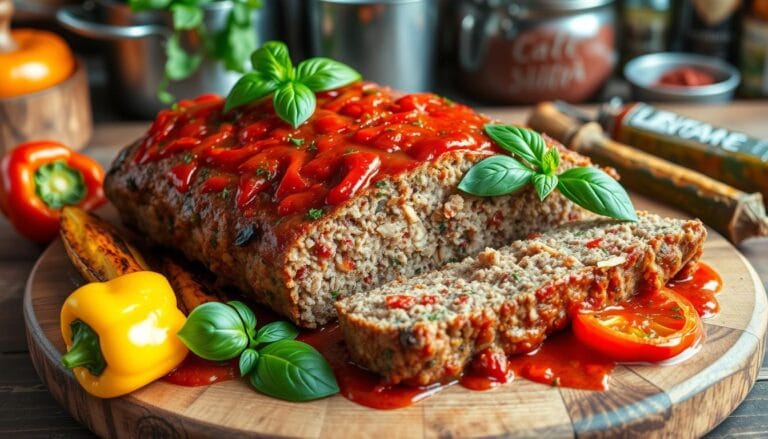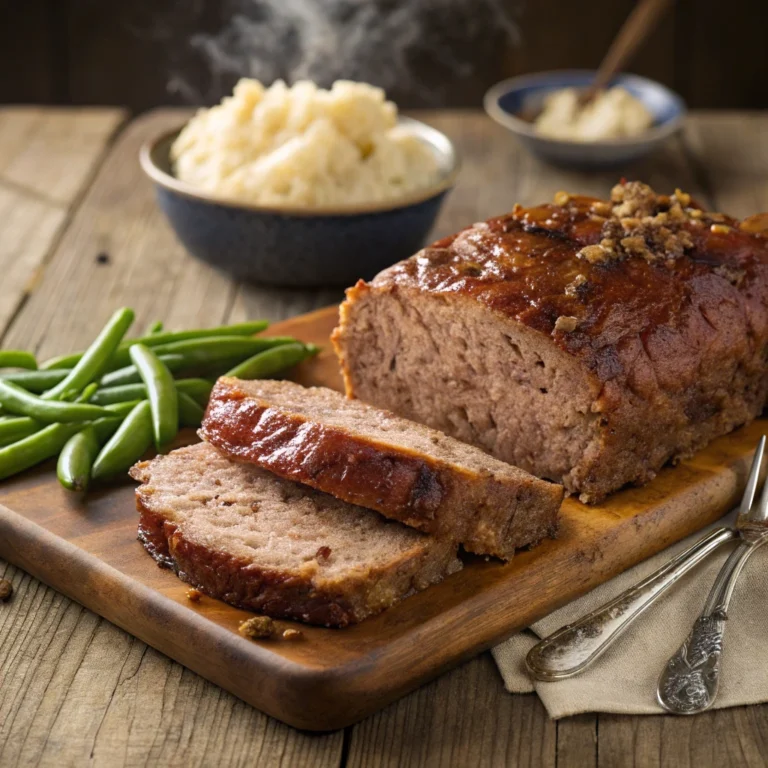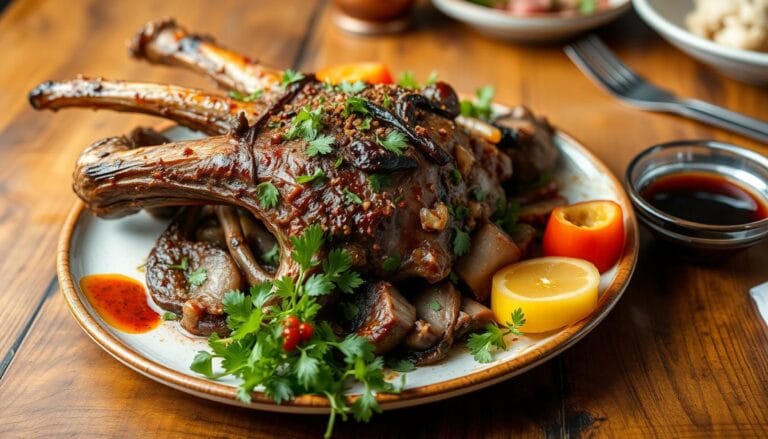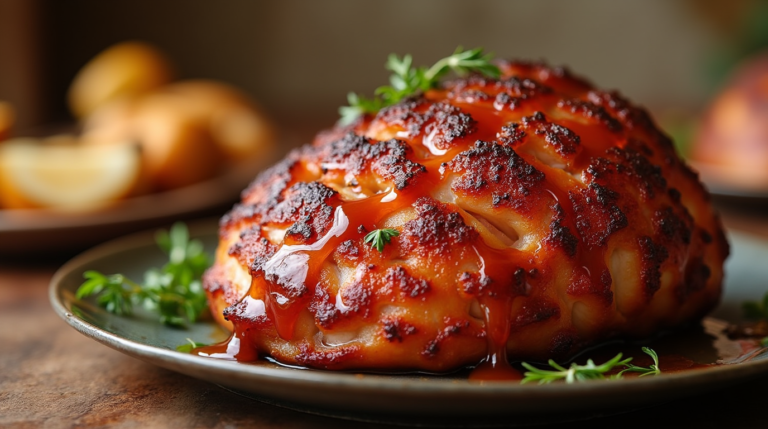How to Cook Turkey Legs: Tips and Techniques
Turkey legs are perfect for small gatherings or as a Thanksgiving alternative. They offer juicy, flavorful dark meat with crispy, golden-brown skin when cooked right. This guide will show you how to cook turkey legs in the oven, on the grill, or in a slow cooker. You’ll learn how to make them tender and delicious every time.
Table of Contents
Understanding Turkey Leg Basics
Turkey legs are often ignored, but they’re worth the attention. Turkey drumsticks and thighs offer a richer taste than white meat. They provide a more flavorful experience.
Selecting the Right Turkey Legs
For the best results, pick turkey legs that are 10-12 ounces each. These sizes are just right, giving you enough meat without being too big.
Dark Meat vs White Meat Benefits
Dark meat turkey, like drumsticks and thighs, is juicier and tastes better. It has more fat, making it tender and moist. White meat, like the breast, is leaner but can dry out easily. Turkey legs also have more protein, with about 55.4g per serving.
Size and Portion Guidelines
Plan for one drumstick per person for serving. This size gives you about 1/2 pound of meat, making for a filling meal. Adjust the number of legs based on your guests’ appetites and any side dishes you’re serving.
| Cut | Approximate Weight | Protein (g) | Fat (g) |
|---|---|---|---|
| Turkey Drumstick | 10-12 oz | 55.4 | 14.5 |
| Turkey Thigh | 12-16 oz | 58.2 | 17.1 |
Essential Equipment and Kitchen Tools
Cooking delicious turkey legs is easier with the right tools. Let’s look at what you need to make your turkey legs a hit.
A rimmed baking sheet with a rack is key. It helps air circulate, making the turkey cook evenly. A good meat thermometer is also vital. It ensures the turkey reaches a safe 165°F.
Having a roasting pan is handy, especially for big batches. It gives you a big, sturdy place for your turkey. Aluminum foil is great for wrapping the legs to prevent over-browning.
Don’t overlook the basting brush. It lets you keep the turkey moist and flavorful by applying butter or oil.
With these tools, you’re ready to make juicy, tender turkey legs. They’ll impress everyone at your table.
How to Cook Turkey Legs
Preparation Steps
To start, pat the turkey legs dry with paper towels. This removes excess moisture. It helps the skin get crispy during cooking.
Temperature Guidelines
Preheat your oven to 425°F (218°C). This high heat makes the skin golden and crispy. The turkey legs need to reach 170°F (77°C) for safety and tenderness.
Cooking Time Charts
The cooking time depends on the turkey leg size. 12-ounce legs cook in 45-50 minutes at 425°F (218°C). Larger 1-pound legs take about 90-120 minutes at 350°F (177°C). Always check with a meat thermometer to ensure the right temperature.
“The key to perfectly cooked turkey legs is to monitor the internal temperature and adjust the cooking time accordingly. This ensures the meat is juicy and the skin is crispy.”
Follow these steps and guidelines for delicious turkey legs. Always use a meat thermometer for safety and the best texture.
Creating the Perfect Seasoning Blend
Make your turkey legs taste amazing with a special seasoning blend. The secret to delicious turkey is in the seasoning. With a few easy ingredients, you can make a blend that will highlight your turkey legs.
A great mix includes smoked paprika, garlic powder, dried rosemary, thyme, sage, salt, and black pepper. This blend adds savory, earthy, and sweet flavors. Or, try an herb butter with softened butter, garlic, thyme, rosemary, sage, Dijon mustard, and brown sugar.
To get the best flavor, gently loosen the turkey’s skin. Rub the seasoning or herb butter on the meat. This way, the flavors soak into the meat, making it juicy and delicious.
Want a quick option? Use a pre-made poultry seasoning blend. These mixes have herbs and spices that go well with turkey. Try different ones to find your favorite.
| Seasoning Rub Ingredients | Compound Butter Ingredients |
|---|---|
|
|
With the right seasoning, your turkey legs will be the main attraction. Try different flavors to find the perfect match for your taste.
Mastering Different Cooking Methods
There are many ways to cook turkey legs, each with its own charm. You can try oven roasting, grilling, or slow cooking. Each method brings out different flavors and textures. Let’s explore these methods to help you cook perfect turkey legs.
Oven Roasting Technique
Oven roasting is a favorite for turkey legs. It gives you crispy skin and juicy meat. Start by heating your oven to 425°F for a golden crust.
Season the legs well and roast them for 15-20 minutes at high heat. This step seals in the flavors. Then, lower the heat to 350°F and cook until the meat is 170°F. This ensures it’s tender and juicy.
Grilling Method
Grilling adds a smoky flavor to turkey legs. Grill them at medium heat, turning often for even cooking. The grill’s heat caramelizes the outside while cooking the inside.
Grill for 1-1.5 hours to reach 170°F. The size of your turkey legs will affect the time.
Slow Cooker Approach
The slow cooker makes turkey legs tender and juicy. Season the legs and add broth or stock. Let it cook on low for 6-8 hours.
By the end, the meat will be tender and flavorful. It’s a great way to cook turkey legs.
Whichever method you choose, always check the turkey’s internal temperature. This ensures it’s cooked just right. With practice, you’ll master cooking turkey legs that impress everyone.
Achieving Crispy Skin and Juicy Meat
Cooking crispy turkey skin and juicy turkey legs is an art. It can make your turkey leg dishes amazing. Follow these turkey leg cooking tips to cook your turkey legs perfectly every time.
To get that crispy skin, start with dry turkey legs. Dry them with paper towels before seasoning and cooking. Roast the legs at 400°F (200°C) for 20-30 minutes first. This high heat helps render fat and crisp the skin.
Before cooking, baste the turkey legs with oil or melted butter. This adds to the crunch. Make sure to turn the legs halfway for even crispiness.
- Pat turkey legs dry with paper towels.
- Roast at 400°F (200°C) for the first 20-30 minutes.
- Baste with oil or melted butter before cooking.
- Rotate legs halfway through cooking time.
To keep the meat juicy and tender, don’t overcook it. Use a meat thermometer to check for 165°F (75°C). Let the turkey legs rest for 10-15 minutes after cooking. This makes the meat moist and flavorful.
Brining the turkey legs before cooking also helps. Soak them in a saltwater brine for 4-12 hours in the fridge. This keeps the meat moist and boosts flavor.
“The secret to juicy, tender turkey legs is all in the resting time. Let them sit for 10-15 minutes before serving, and you’ll be rewarded with a meal that’s bursting with flavor.”
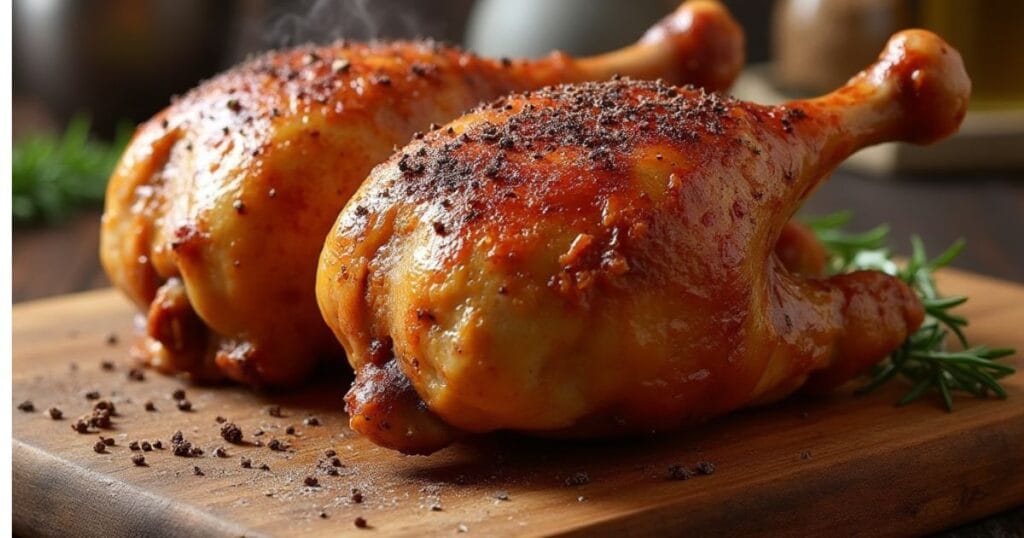
By following these tips, you’ll get perfect crispy skin and juicy meat every time. Enjoy the delicious results and impress your guests with your turkey leg skills.
Common Mistakes to Avoid
Cooking the perfect turkey legs is a delicate task. Avoiding common mistakes is key to getting juicy, flavorful results. Issues like temperature control, seasoning, and resting time can all go wrong.
Temperature Control Issues
One big mistake is not keeping the right temperature. Cooking too low makes the skin rubbery, while too high makes the meat dry. Use a meat thermometer to check the internal temperature. Aim for 165°F in the thickest part of the meat.
Seasoning Errors
Don’t under-season your turkey legs. Be generous with your seasoning, both on the surface and under the skin. This ensures the meat is full of flavor. Without enough seasoning, your turkey legs might taste flat.
Resting Time Problems
Skipping the resting time is another mistake. Letting the turkey legs rest for 10-15 minutes before serving is crucial. It helps the juices spread evenly, making the meat moist and flavorful. Cutting into the turkey too soon can let the juices out, leaving it dry.
By avoiding these common turkey cooking mistakes, turkey leg troubleshooting, and following best turkey cooking tips, you’ll master cooking turkey legs perfectly every time.
Serving Suggestions and Side Dishes
Choosing the right side dishes can make your turkey dinner unforgettable. From classic Thanksgiving favorites to new ideas, there’s a lot to try. Let’s look at some tasty side dishes that will make your turkey dinner a hit.
For a traditional Thanksgiving, pair your turkey with cranberry sauce, mashed potatoes, and green bean casserole. These sides offer a nice contrast to the turkey and bring back holiday memories.
For lighter options, try roasting seasonal vegetables like Brussels sprouts, carrots, and sweet potatoes. You can also serve a fresh salad or creamy cauliflower mash for a lighter choice.
For a special treat, make macaroni and cheese, chili cheese fries, or cornbread dressing. These sides add richness and comfort to your turkey dinner.
The secret to a great turkey dinner is balancing flavors and textures. By mixing different turkey leg side dishes, Thanksgiving sides, and turkey dinner ideas, you’ll please everyone and leave them wanting more.

Storage and Reheating Tips
Storing and reheating leftover turkey legs right is key to keeping their taste and texture. Follow a few easy steps to enjoy your turkey for days.
Proper Storage Methods
Cooked turkey legs can stay in the fridge for 3-4 days in airtight containers. For longer storage, freeze them for up to 3 months. Wrap them tightly in plastic or foil to avoid freezer burn.
Best Reheating Practices
There are several ways to reheat turkey legs. For crispy skin, oven heat at 325°F for 15-20 minutes until it’s 165°F inside. You can also use an air fryer for quick skin crispiness.
For a quicker option, the microwave works but be careful not to dry it out. Heat at 50% power for 2-3 minutes per leg. The slow cooker is also good for gentle reheating, cooking on high for 3-4 hours or low for 6-8 hours.
Always make sure the turkey leftovers hit 165°F for safety. Brush them with oil or melted butter to keep them moist and flavorful.
By using these leftover turkey storage and reheating tips, you can enjoy your turkey legs for a long time. A bit of care ensures they taste as great as the first time.
Conclusion
Turkey legs are a tasty and affordable choice for small groups or everyday meals. They offer juicy meat and crispy skin with the right seasoning and cooking. Try oven roasting, grilling, or slow cooking to find your favorite way to cook them.
Looking for a Thanksgiving alternatives to the big turkey? Turkey legs are a simpler, budget-friendly option that still packs a flavor punch. They’re perfect for a casual family dinner or a special holiday meal.
With the tips from this guide, you’ll make a easy turkey dinner that everyone will love. Turkey legs are versatile, so get creative with seasonings and cooking methods. They’ll become a favorite in your kitchen.
FAQ
What are the benefits of turkey legs compared to white meat?
How much turkey leg should I plan per person?
What equipment do I need to cook turkey legs?
What’s the best way to achieve crispy skin on turkey legs?
How do I know when the turkey legs are fully cooked?
Can I use a slow cooker to cook turkey legs?
How should I store and reheat leftover turkey legs?
Did you enjoy making our recipe?
There are no reviews yet. Be the first one to write one.


